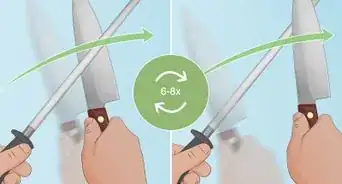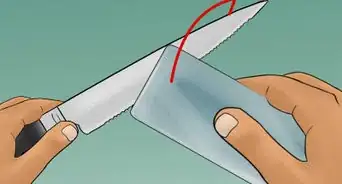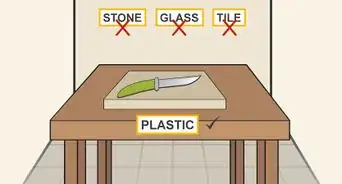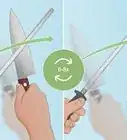This article was co-authored by Ollie George Cigliano and by wikiHow staff writer, Jessica Gibson. Ollie George Cigliano is a Private Chef, Food Educator, and Owner of Ollie George Cooks, based in Long Beach, California. With over 20 years of experience, she specializes in utilizing fresh, fun ingredients and mixing traditional and innovative cooking techniques. Ollie George holds a BA in Comparative Literature from The University of California, Berkeley, and a Nutrition and Healthy Living Certificate from eCornell University.
There are 7 references cited in this article, which can be found at the bottom of the page.
This article has been viewed 181,029 times.
One of the first skills that a chef learns is how to quickly chop vegetables, like onions and peppers, and meat. If you're struggling to chop food safely and efficiently, ensure that you're using the right tools (like a good cutting board and chef's knife). Learn how to hold the knife correctly and use the right chopping technique for your kitchen task. With a little practice, you'll become more confident and capable at chopping food.
Steps
Choosing a Cutting Surface and Knife
-
1Choose a cutting board. You can choose cutting boards made from wood, bamboo, or plastic. Plastic is lightweight and easy to store, but it can be difficult to clean. You'll need to discard any plastic cutting boards that develop knife scars or ridges. Wood cutting boards have natural antiseptic properties that can help keep them clean. You can also use bamboo, but since it's harder than wood, it may dull your knives faster.[1]
- Avoid chopping on metal, glass, or stone cutting boards. These can dull your knives.
- Consider getting two cutting boards. Use a wooden one to chop vegetables or fruit and use a plastic one to chop meat.
-
2Secure the cutting board. If you choose to use a plastic cutting board or your work surface is a little slick, you'll need to prevent the cutting board from slipping around. This could cause the knife to slip and cut you. To keep the cutting board in place, lay a damp cloth on the work surface. Set the cutting board directly on the cloth. The board should not slide around.[2]
- You could also use non-slip mats, wet paper towels, or poster putty underneath the cutting board.
Advertisement -
3Use the right knife for the job. Most knife sets include a variety of knives that you'll use for different kitchen jobs. To chop, you'll usually want to use an 8 to 10-inch (20 to 25 cm) chef's knife. It has a slight curve, so you can rock the knife back and forth as you quickly chop. The knife should feel a little heavy and balanced when you hold it.[3]
- Don't chop food with small knives (like paring knives) since the knife could become stuck in the food or you may cut yourself.
- Avoid using it for small jobs, like peeling food or cutting bread.
-
4Keep the knife sharp. Professional chefs sharpen their blades every day because they use them so often. Be in the habit of sharpening your knife blade using a sharpening stone since dull knives are more likely to slip while you're using them. This can increase your risk of cutting yourself. If you don't feel comfortable sharpening your own knives, you can send your knives away to a professional sharpening service. However, when you do it yourself, you have more control over the result.
- If the knife blade has been bent off center because of frequent use, you can also use a honing steel to push the blade back into balance.[4]
- Do not wash your knife in the dishwasher. Wash in hot soapy water and dry by hand.
Holding and Positioning the Knife
-
1Hold your chef's knife with your dominant hand. Use your dominant hand to grip the handle of the knife with your middle, ring, and pinkie fingers. Your index finger and thumb should be on the blade in front of the bolster, the thick part of the blade where it meets the handle. Try not to lay your index finger across the top of the blade. It should rest flat against the blade near the handle. Gripping the blade will give you more control as you chop and put less pressure on your wrist and hand.[5]
- While you can still chop while completely holding the handle with your entire hand, you won't have the best range of movement.
- The index finger and thumb should look like they're pinching the sides of the blade.
-
2Form a claw with your subordinate hand. The hand that's not holding the knife should hold the food that you're cutting steady. To prevent the knife from cutting your subordinate hand, curve your fingertips in towards your palm, so your hand forms a claw. Set your clawed hand on the food you're cutting, so the food can't move or slide.[6]
- This might not feel natural when you start practicing, but it's the best way to prevent kitchen accidents.
-
3Protect the thumb on your subordinate hand. It's important to tuck in the thumb of your helping hand, so you're less likely to cut it. The knuckles on your thumb and fingertips should be closer to the knife blade than the fingertips. This way, your knife will simply bump against the knuckles instead of cutting the fingertips if you chop quickly.[7]
- Practice keeping your thumb tucked in. If you notice your thumb sticking out while you're cutting, stop and tuck your thumb in again. Practice while going a little slower until it becomes a habit.
Using Different Chopping Techniques
-
1Practice the cross chop. If you're just learning to chop, the cross chop is a great and safe technique. Place the food you want to chop on your cutting board and hold your chef's knife with your dominant hand. Open your subordinate hand and lay the palm where it meets the fingers on top of the blade. Keep your fingers open and out while the other hand rocks the blade to roughly chop the food. Continue to chop the food until it's the size you want.
- The cross chop is good for chopping foods that will cook down, since the pieces may not be uniform.
-
2Learn the tap chop. If you'd chop something into slices, hold the item steady with the thumb of your subordinate hand. Extend your fingers towards the end of the food where you'll begin slicing. Curl those fingertips in to protect them from the blade. Raise the blade straight up and bring it straight back down to make a slice. Continue to slowly bring the blade up and tap it back down as you walk your fingertips back.
- Keep your thumb away from the blade and continue to hold the food steady.
- You won't be rocking the blade as you tap chop.
-
3Try the rock chop. To finely chop or mince fresh herbs or small items (like garlic), chop the food for a few seconds, so it's roughly chopped. Gather the food together and lay the fingertips of your subordinate hand on the end of the blade. Use the handle of the knife to rock the blade up and down. The subordinate hand should steady the blade as it rocks. Keep scooping the food into a pile, so you can rock chop it until it's as fine as you'd like.[8]
- The rock chop works well with a chef's knife because the blade is slightly curved. This makes it easy to rock the blade as it chops.
Community Q&A
-
QuestionWhat's a good technique for chopping, dicing and mincing vegetables?
 Community AnswerPlace the tip of the knife on the cutting board, and the vegetables under the knife. The handle should be raised. Bring the knife down, increasing speed as you go.
Community AnswerPlace the tip of the knife on the cutting board, and the vegetables under the knife. The handle should be raised. Bring the knife down, increasing speed as you go. -
QuestionWhat's the best way to cut a single carrot into match-sized sticks?
 Community AnswerFirst, cut the carrot into two halves, then create thin slices. Then you can easily chop them into any size you need.
Community AnswerFirst, cut the carrot into two halves, then create thin slices. Then you can easily chop them into any size you need. -
QuestionHow can I cut a pepper?
 Community AnswerFirst, you need to cut off the top. Then you remove the seeds, and core the pepper. After that, you can slice it to the preferred size.
Community AnswerFirst, you need to cut off the top. Then you remove the seeds, and core the pepper. After that, you can slice it to the preferred size.
Things You'll Need
- Wooden cutting board
- Plastic cutting board
- Wet cloth or non-slip mat
- Chef's knife
- Sharpening stone or honing steel
- Vegetables or meat
References
- ↑ https://www.thekitchn.com/whats-the-best-kind-of-cutting-board-plastic-wood-or-bamboo-51821
- ↑ https://www.thekitchn.com/quick-tips-five-ways-to-keep-y-89582
- ↑ http://www.epicurious.com/archive/kitchenequipment/essentials/knives
- ↑ https://www.thekitchn.com/did-you-know-this-steel-doesnt-actually-sharpen-knives-211855
- ↑ http://www.seriouseats.com/2010/05/knife-skills-how-to-hold-a-knife.html
- ↑ https://cooking.nytimes.com/guides/23-basic-knife-skills
- ↑ https://cooking.nytimes.com/guides/23-basic-knife-skills
- ↑ http://www.seriouseats.com/2014/05/draftknife-skills-the-three-basic-knife-cuts.html
About This Article
To chop food, first grab a chef’s knife and hold it so your thumb and forefinger are resting on the blade. Gripping the blade with your fingers will give you more control. Hold the fruit or vegetable you’re chopping down on a cutting board with your other hand. Tuck your fingertips under your knuckles to prevent cutting yourself, and keep your thumb and pinky on the cutting board for more stability. Then, place the tip of the blade on the cutting board, and bring the handle down to chop through the food. Lift the handle back up, move your fingers, and repeat. If your recipe says to dice the food, chop it into ¼-inch (0.6-cm) cubes. For a brunoise cut, chop the food into ⅛-inch (0.3-cm) cubes. If you need to mince the food, chop it up even smaller, into about 1/16-inch (0.15 cm) cubes. To julienne something, cut it into strips that are 2 inches (5 cm) long and ⅛ inch (0.3 cm) thick. If you’re chopping something that’s round, like an onion, start by cutting it in half from the top to the bottom. Then, place the flat side down on the cutting board, and make a series of evenly-spaced horizontal cuts almost all of the way through. Next, make a series of vertical cuts down through the food, moving from one side to the other. Finally, make perpendicular cuts down through the other cuts you made to chop the food into small cubes.




















































